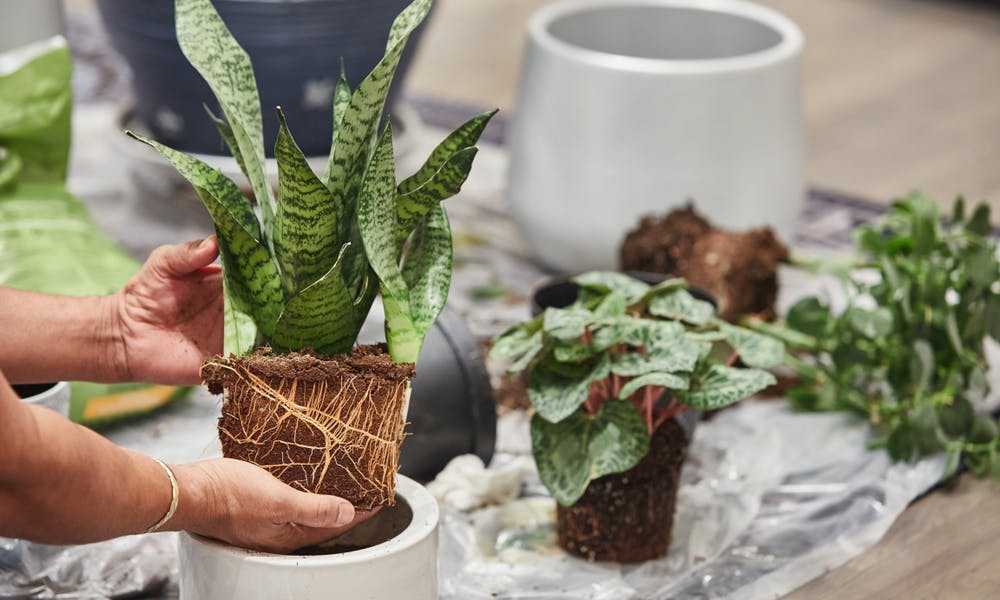MENU
Snake Plant Care: the Evergreen Mother-in-law’s Tongue

The plant that is commonly known as the mother-in-law’s tongue is the perfect plant for indoors and outdoors. They are the easiest plants to take care of especially if you are a beginner, or you want to stay away from sensitive, care-intensive plants. The snake plant is a beautiful and useful addition to your garden, known for retaining toxins and purifying the air. Read more below to find out about the snake plant care:
* History of the snake plant
* Characteristics
* Snake plant care
* Pitfalls of snake plant care
History of the Snake Plant
The snake plant is a plant native to Africa and Asia. It is also known as the mother-in-law’s tongue, devil’s tongue, and other similar names. African tribes used them for bowstrings, perhaps because the plant is also mildly toxic.
For the first time, this plant was brought in Europe by the Italian Prince of Sanseviero in the 18th century and, therefore, it is also known as the Sansevieria.
This plant can grow up to 12 feet as it enjoys the sun but make sure to not keep it in the direct sunlight. It is recommended to keep the snake plant in a slightly shaded corner for best results. Be careful when you water it, as too much water can have adverse effects on its health. The plant is mildy toxic, so it is important not to ingest it, especially keeping children away since they are attracted to colors.
Characteristics
The snake plant’s leaves are blade-shaped with multiple green shades. They can grow up to 12 feet standing straight up. The roots are very shallow and do not grow down so you need to plant it in a pot that is more of a counterweight for it. There are several varieties of this plant and some of them have flowers in various colors.
It has from six to eight leaves that are very tough and blade-like edges that are pretty sharp.
Snake Plant Care
The first step of the snake plant care routine starts with planting. You have to plant it in a pot that acts as a counterweight because it grows straight up, and its roots are quite sensitive.
It can survive in any environment with no issues. The temperature is better to be higher since this plant comes from the hot African climates. Do not allow contact with frozen temperature and do not let the plant touch the frozen windows during the winter because the leaves start to dry.
When watering the snake plant, we need to be scarce. The plant loves water, but not too much. The snake plant can survive without water for a couple of weeks because it uses the humidity from the air and what is already in the leaves. Furthermore, do not leave it too many weeks without water because it loses color, elasticity, and becomes soft. Basically, if you leave it without water for more than three or four weeks the plant withers.
When you want to change the pot or the soil of the snake plant, you have to add universal soil and remember to add some little stones on the bottom of the pot. On the stones, add sand and after that, the universal soil. The stones and the sand help to drain the excess water.
When cleaning the dried or wilted leaves, all you need to do is just cut them or pull them out because they can be removed very easily since the leaves are dry. By doing so, the plant has a better chance of growing more leaves with beautiful colors and remains healthy for a longer period of time. So, when you see that a leaf or some leaves change color, remove them and make room for younger ones. However, be careful not to remove too many leaves at once because this stops the plant’s growth.
If you want to clean your flower and give it a shine, just get a piece of a cloth dampened in warm water and clean each leaf slowly; ensure that you do not push too hard, otherwise, it can easily get broken. You can put a bit of vinegar in as well when you clean the leaves; the vinegar protects the snake plant against bugs and the shine of the leaves is restored, with brighter and livelier color.
Pitfalls of Snake Plant Care
If you water it excessively, your plant can easily wither. As it is a low-maintenance plant, it does not require constant watering or cleaning. Furthermore, as long as you keep it indoors in a semi-shaded corner, you should rest assured that your snake plant is healthy and thriving.
On the other hand, if you inspect the plant and notice any yellow spots on its leaves, this is a sign that the plant gets burnt. Make sure to take it out from the direct sunlight and find a better place in the semi-shade.
The snake plants can also be affected by spider mites and mealybugs. They suck the sap out from the leaves, wilting the plant if you do not remove them. Once your snake plant gets injured by these insects, it is even more vulnerable to other pests and diseases.
It is recommended to drive the mealybugs away by picking them by hand and dab some alcohol on them. Additionally, the spider mites can simply be washed away with the water as they are not lovers of humidity and simply increasing the humidity around the plant lowers the chance of them coming back.
All in all, the evergreen snake plant is easy to care for. It is mildly toxic, which might be the root of its popular name as the mother-in-law’s tongue. Despite this, it is the perfect plant for any beginner, low-maintenance and very resistant to diseases and pests.

